Management and Operations (HNBS 304) - Starbucks Manager vs Leader
VerifiedAdded on 2020/07/22
|10
|2802
|44
Report
AI Summary
This report examines the roles and characteristics of managers and leaders within Starbucks, a global coffeehouse chain. The report begins by defining and comparing the roles of managers and leaders, highlighting their distinct responsibilities and qualities. It differentiates between managerial functions and leadership roles, analyzing their application in various situations, such as decision-making, training, and delegation. The report then explores different leadership theories and approaches, including system leadership, situational theory, and contingency leadership, evaluating their respective strengths and weaknesses. The analysis includes a critical discussion of these theories, offering insights into their practical implications for Starbucks and similar organizations. Overall, the report provides a comprehensive overview of leadership and management principles, using Starbucks as a relevant and illustrative case study.
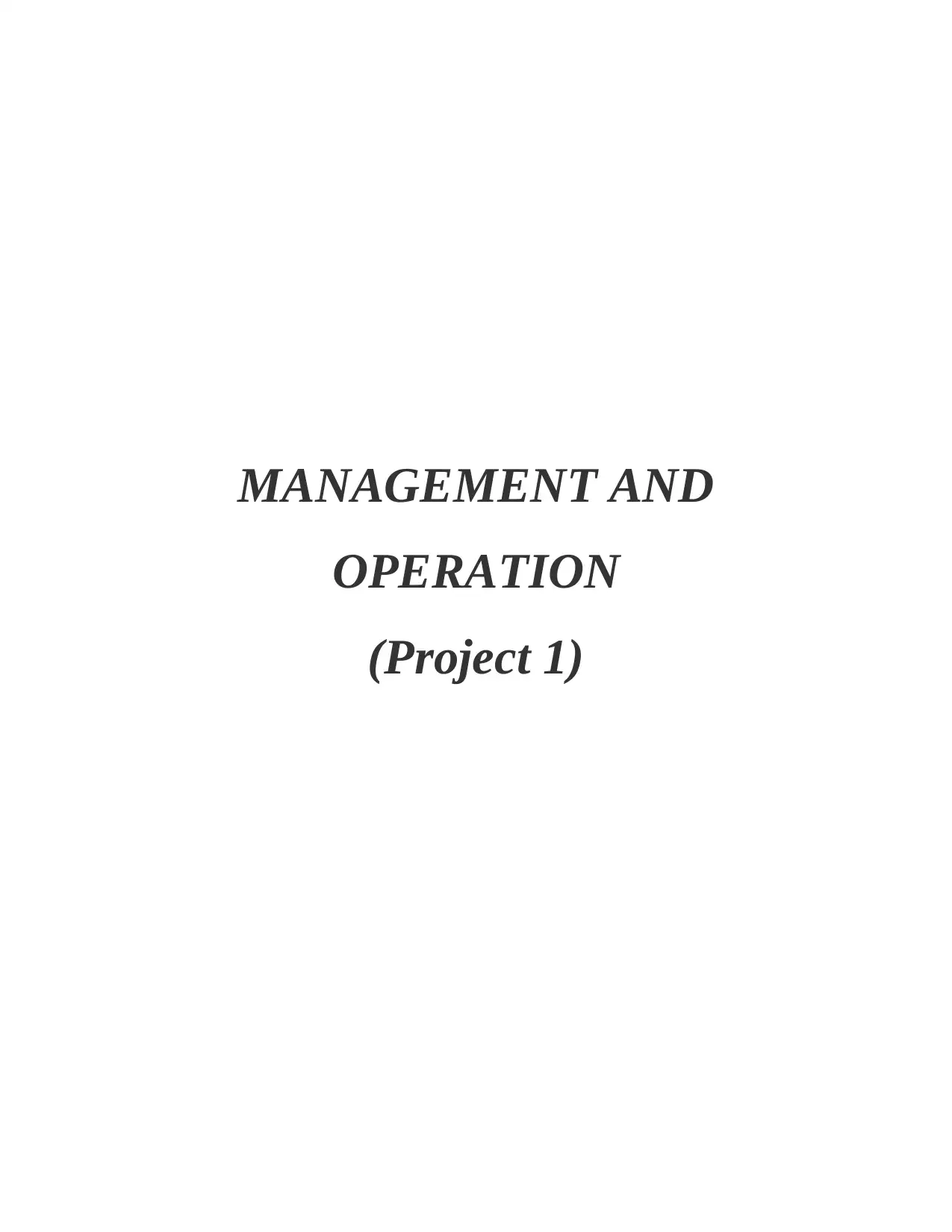
MANAGEMENT AND
OPERATION
(Project 1)
OPERATION
(Project 1)
Paraphrase This Document
Need a fresh take? Get an instant paraphrase of this document with our AI Paraphraser
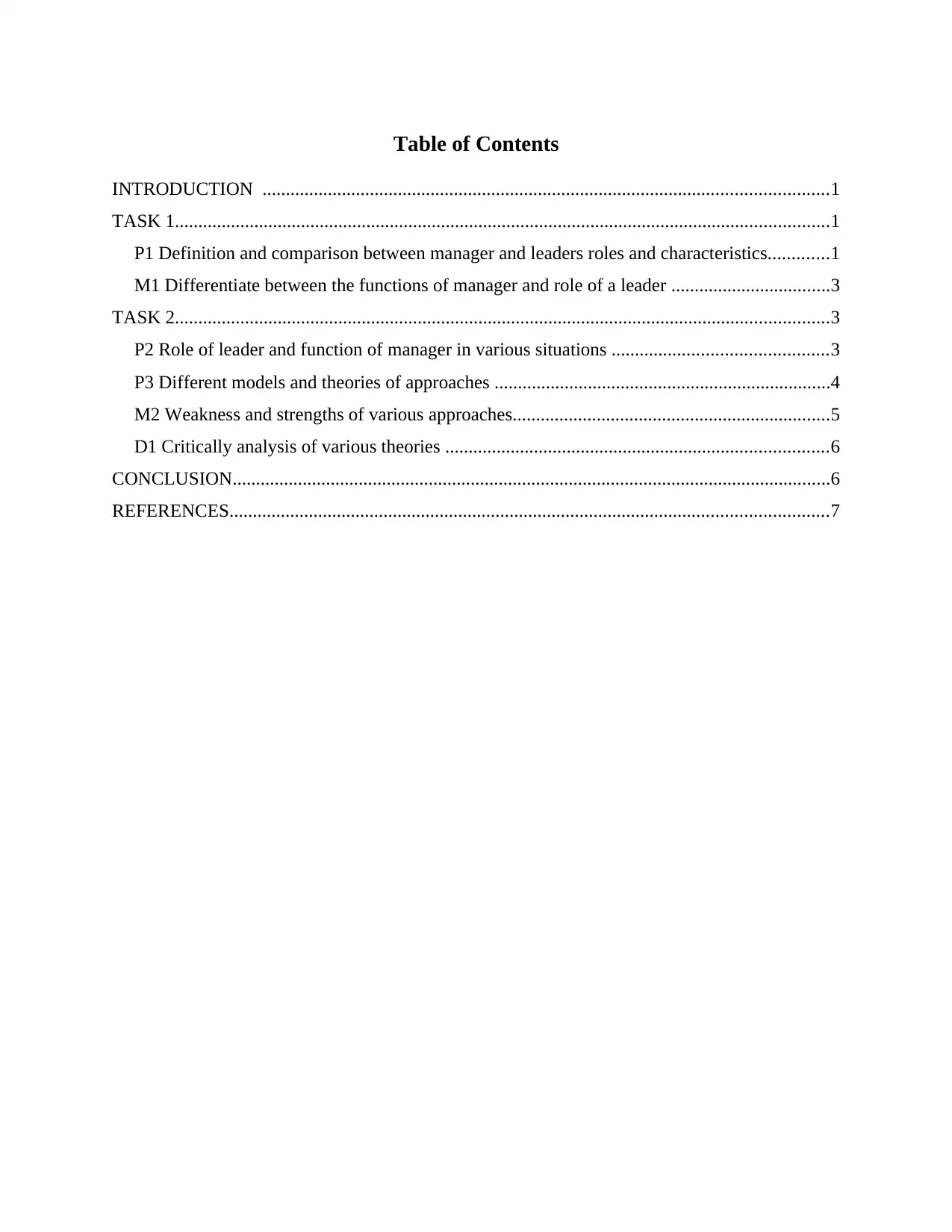
Table of Contents
INTRODUCTION .........................................................................................................................1
TASK 1............................................................................................................................................1
P1 Definition and comparison between manager and leaders roles and characteristics.............1
M1 Differentiate between the functions of manager and role of a leader ..................................3
TASK 2............................................................................................................................................3
P2 Role of leader and function of manager in various situations ..............................................3
P3 Different models and theories of approaches ........................................................................4
M2 Weakness and strengths of various approaches....................................................................5
D1 Critically analysis of various theories ..................................................................................6
CONCLUSION................................................................................................................................6
REFERENCES................................................................................................................................7
INTRODUCTION .........................................................................................................................1
TASK 1............................................................................................................................................1
P1 Definition and comparison between manager and leaders roles and characteristics.............1
M1 Differentiate between the functions of manager and role of a leader ..................................3
TASK 2............................................................................................................................................3
P2 Role of leader and function of manager in various situations ..............................................3
P3 Different models and theories of approaches ........................................................................4
M2 Weakness and strengths of various approaches....................................................................5
D1 Critically analysis of various theories ..................................................................................6
CONCLUSION................................................................................................................................6
REFERENCES................................................................................................................................7

⊘ This is a preview!⊘
Do you want full access?
Subscribe today to unlock all pages.

Trusted by 1+ million students worldwide
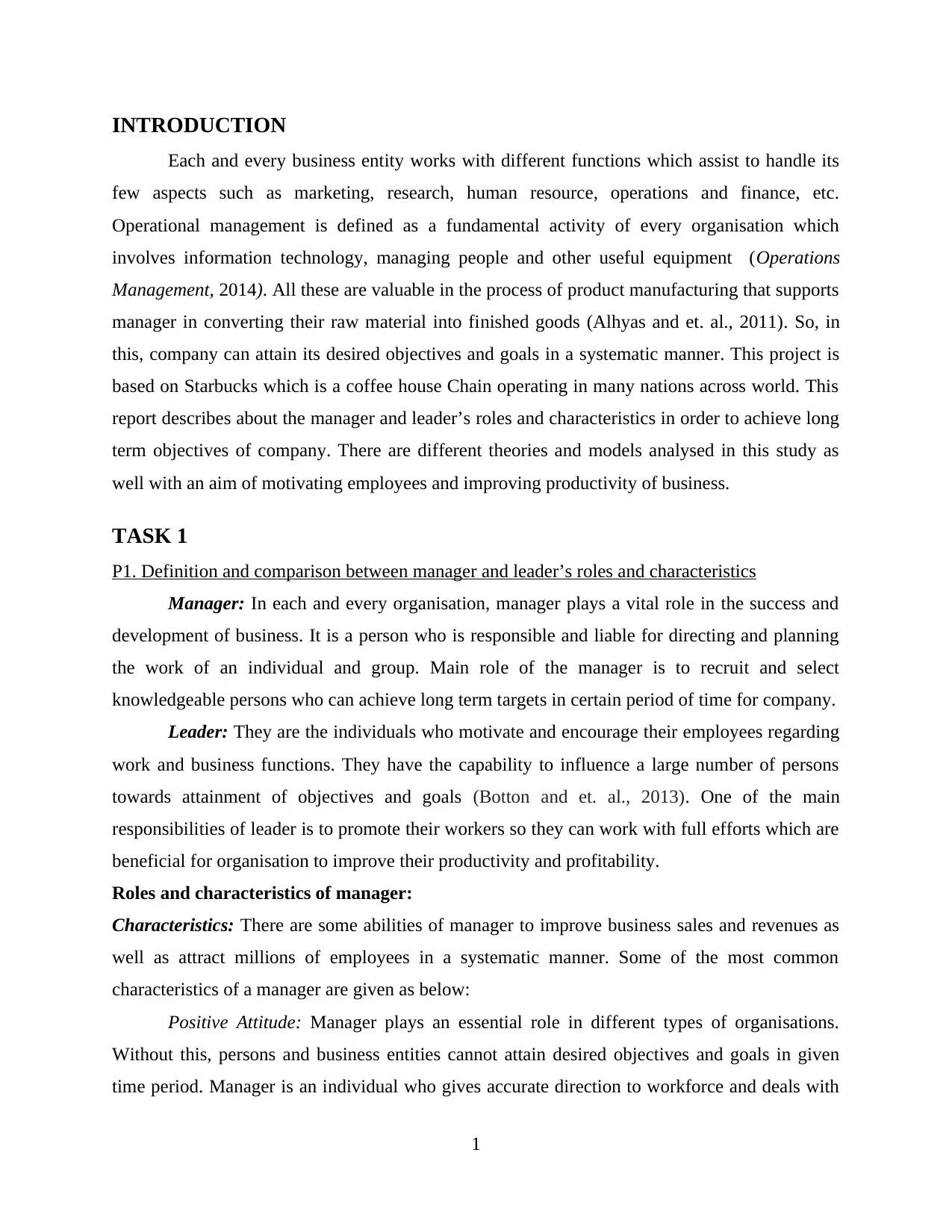
INTRODUCTION
Each and every business entity works with different functions which assist to handle its
few aspects such as marketing, research, human resource, operations and finance, etc.
Operational management is defined as a fundamental activity of every organisation which
involves information technology, managing people and other useful equipment (Operations
Management, 2014). All these are valuable in the process of product manufacturing that supports
manager in converting their raw material into finished goods (Alhyas and et. al., 2011). So, in
this, company can attain its desired objectives and goals in a systematic manner. This project is
based on Starbucks which is a coffee house Chain operating in many nations across world. This
report describes about the manager and leader’s roles and characteristics in order to achieve long
term objectives of company. There are different theories and models analysed in this study as
well with an aim of motivating employees and improving productivity of business.
TASK 1
P1. Definition and comparison between manager and leader’s roles and characteristics
Manager: In each and every organisation, manager plays a vital role in the success and
development of business. It is a person who is responsible and liable for directing and planning
the work of an individual and group. Main role of the manager is to recruit and select
knowledgeable persons who can achieve long term targets in certain period of time for company.
Leader: They are the individuals who motivate and encourage their employees regarding
work and business functions. They have the capability to influence a large number of persons
towards attainment of objectives and goals (Botton and et. al., 2013). One of the main
responsibilities of leader is to promote their workers so they can work with full efforts which are
beneficial for organisation to improve their productivity and profitability.
Roles and characteristics of manager:
Characteristics: There are some abilities of manager to improve business sales and revenues as
well as attract millions of employees in a systematic manner. Some of the most common
characteristics of a manager are given as below:
Positive Attitude: Manager plays an essential role in different types of organisations.
Without this, persons and business entities cannot attain desired objectives and goals in given
time period. Manager is an individual who gives accurate direction to workforce and deals with
1
Each and every business entity works with different functions which assist to handle its
few aspects such as marketing, research, human resource, operations and finance, etc.
Operational management is defined as a fundamental activity of every organisation which
involves information technology, managing people and other useful equipment (Operations
Management, 2014). All these are valuable in the process of product manufacturing that supports
manager in converting their raw material into finished goods (Alhyas and et. al., 2011). So, in
this, company can attain its desired objectives and goals in a systematic manner. This project is
based on Starbucks which is a coffee house Chain operating in many nations across world. This
report describes about the manager and leader’s roles and characteristics in order to achieve long
term objectives of company. There are different theories and models analysed in this study as
well with an aim of motivating employees and improving productivity of business.
TASK 1
P1. Definition and comparison between manager and leader’s roles and characteristics
Manager: In each and every organisation, manager plays a vital role in the success and
development of business. It is a person who is responsible and liable for directing and planning
the work of an individual and group. Main role of the manager is to recruit and select
knowledgeable persons who can achieve long term targets in certain period of time for company.
Leader: They are the individuals who motivate and encourage their employees regarding
work and business functions. They have the capability to influence a large number of persons
towards attainment of objectives and goals (Botton and et. al., 2013). One of the main
responsibilities of leader is to promote their workers so they can work with full efforts which are
beneficial for organisation to improve their productivity and profitability.
Roles and characteristics of manager:
Characteristics: There are some abilities of manager to improve business sales and revenues as
well as attract millions of employees in a systematic manner. Some of the most common
characteristics of a manager are given as below:
Positive Attitude: Manager plays an essential role in different types of organisations.
Without this, persons and business entities cannot attain desired objectives and goals in given
time period. Manager is an individual who gives accurate direction to workforce and deals with
1
Paraphrase This Document
Need a fresh take? Get an instant paraphrase of this document with our AI Paraphraser
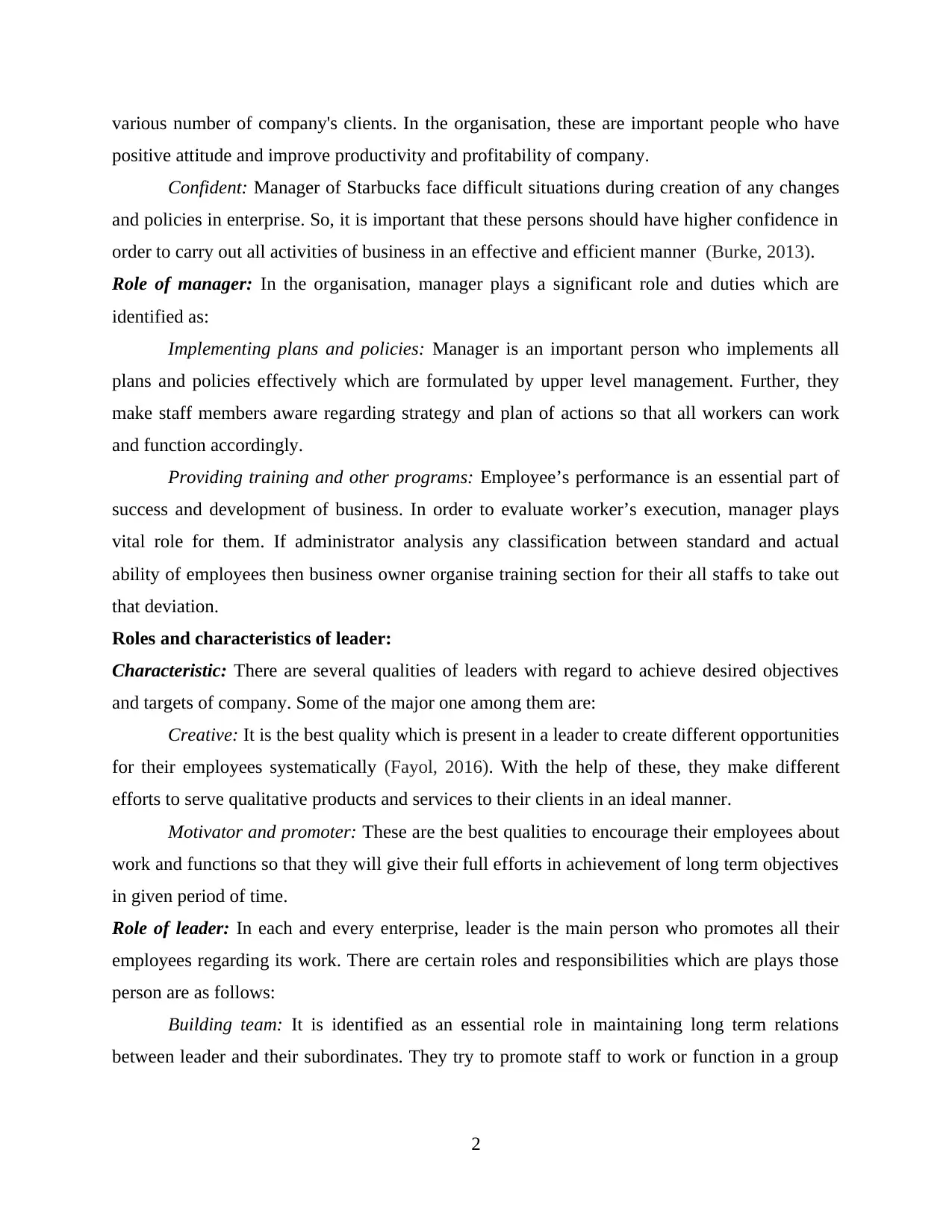
various number of company's clients. In the organisation, these are important people who have
positive attitude and improve productivity and profitability of company.
Confident: Manager of Starbucks face difficult situations during creation of any changes
and policies in enterprise. So, it is important that these persons should have higher confidence in
order to carry out all activities of business in an effective and efficient manner (Burke, 2013).
Role of manager: In the organisation, manager plays a significant role and duties which are
identified as:
Implementing plans and policies: Manager is an important person who implements all
plans and policies effectively which are formulated by upper level management. Further, they
make staff members aware regarding strategy and plan of actions so that all workers can work
and function accordingly.
Providing training and other programs: Employee’s performance is an essential part of
success and development of business. In order to evaluate worker’s execution, manager plays
vital role for them. If administrator analysis any classification between standard and actual
ability of employees then business owner organise training section for their all staffs to take out
that deviation.
Roles and characteristics of leader:
Characteristic: There are several qualities of leaders with regard to achieve desired objectives
and targets of company. Some of the major one among them are:
Creative: It is the best quality which is present in a leader to create different opportunities
for their employees systematically (Fayol, 2016). With the help of these, they make different
efforts to serve qualitative products and services to their clients in an ideal manner.
Motivator and promoter: These are the best qualities to encourage their employees about
work and functions so that they will give their full efforts in achievement of long term objectives
in given period of time.
Role of leader: In each and every enterprise, leader is the main person who promotes all their
employees regarding its work. There are certain roles and responsibilities which are plays those
person are as follows:
Building team: It is identified as an essential role in maintaining long term relations
between leader and their subordinates. They try to promote staff to work or function in a group
2
positive attitude and improve productivity and profitability of company.
Confident: Manager of Starbucks face difficult situations during creation of any changes
and policies in enterprise. So, it is important that these persons should have higher confidence in
order to carry out all activities of business in an effective and efficient manner (Burke, 2013).
Role of manager: In the organisation, manager plays a significant role and duties which are
identified as:
Implementing plans and policies: Manager is an important person who implements all
plans and policies effectively which are formulated by upper level management. Further, they
make staff members aware regarding strategy and plan of actions so that all workers can work
and function accordingly.
Providing training and other programs: Employee’s performance is an essential part of
success and development of business. In order to evaluate worker’s execution, manager plays
vital role for them. If administrator analysis any classification between standard and actual
ability of employees then business owner organise training section for their all staffs to take out
that deviation.
Roles and characteristics of leader:
Characteristic: There are several qualities of leaders with regard to achieve desired objectives
and targets of company. Some of the major one among them are:
Creative: It is the best quality which is present in a leader to create different opportunities
for their employees systematically (Fayol, 2016). With the help of these, they make different
efforts to serve qualitative products and services to their clients in an ideal manner.
Motivator and promoter: These are the best qualities to encourage their employees about
work and functions so that they will give their full efforts in achievement of long term objectives
in given period of time.
Role of leader: In each and every enterprise, leader is the main person who promotes all their
employees regarding its work. There are certain roles and responsibilities which are plays those
person are as follows:
Building team: It is identified as an essential role in maintaining long term relations
between leader and their subordinates. They try to promote staff to work or function in a group
2
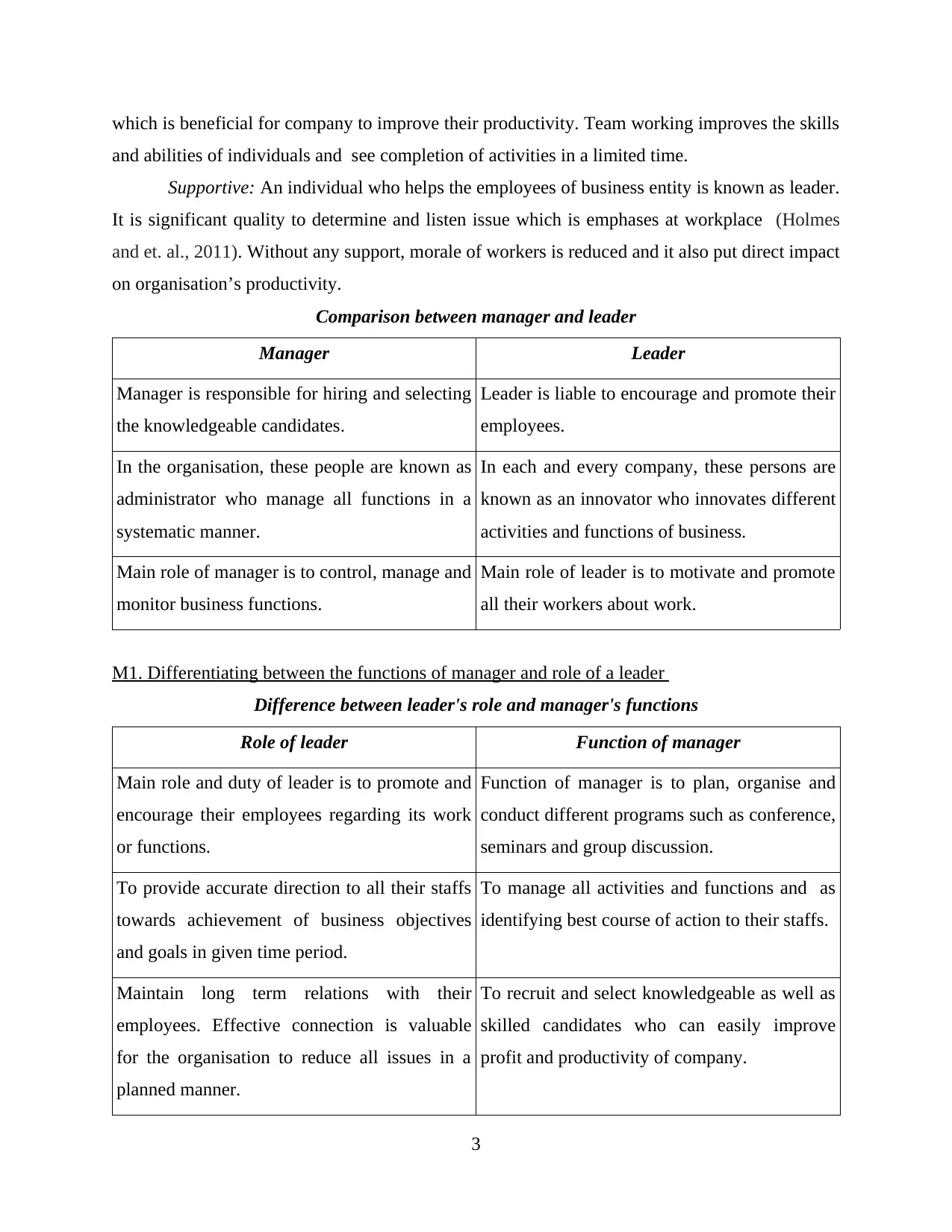
which is beneficial for company to improve their productivity. Team working improves the skills
and abilities of individuals and see completion of activities in a limited time.
Supportive: An individual who helps the employees of business entity is known as leader.
It is significant quality to determine and listen issue which is emphases at workplace (Holmes
and et. al., 2011). Without any support, morale of workers is reduced and it also put direct impact
on organisation’s productivity.
Comparison between manager and leader
Manager Leader
Manager is responsible for hiring and selecting
the knowledgeable candidates.
Leader is liable to encourage and promote their
employees.
In the organisation, these people are known as
administrator who manage all functions in a
systematic manner.
In each and every company, these persons are
known as an innovator who innovates different
activities and functions of business.
Main role of manager is to control, manage and
monitor business functions.
Main role of leader is to motivate and promote
all their workers about work.
M1. Differentiating between the functions of manager and role of a leader
Difference between leader's role and manager's functions
Role of leader Function of manager
Main role and duty of leader is to promote and
encourage their employees regarding its work
or functions.
Function of manager is to plan, organise and
conduct different programs such as conference,
seminars and group discussion.
To provide accurate direction to all their staffs
towards achievement of business objectives
and goals in given time period.
To manage all activities and functions and as
identifying best course of action to their staffs.
Maintain long term relations with their
employees. Effective connection is valuable
for the organisation to reduce all issues in a
planned manner.
To recruit and select knowledgeable as well as
skilled candidates who can easily improve
profit and productivity of company.
3
and abilities of individuals and see completion of activities in a limited time.
Supportive: An individual who helps the employees of business entity is known as leader.
It is significant quality to determine and listen issue which is emphases at workplace (Holmes
and et. al., 2011). Without any support, morale of workers is reduced and it also put direct impact
on organisation’s productivity.
Comparison between manager and leader
Manager Leader
Manager is responsible for hiring and selecting
the knowledgeable candidates.
Leader is liable to encourage and promote their
employees.
In the organisation, these people are known as
administrator who manage all functions in a
systematic manner.
In each and every company, these persons are
known as an innovator who innovates different
activities and functions of business.
Main role of manager is to control, manage and
monitor business functions.
Main role of leader is to motivate and promote
all their workers about work.
M1. Differentiating between the functions of manager and role of a leader
Difference between leader's role and manager's functions
Role of leader Function of manager
Main role and duty of leader is to promote and
encourage their employees regarding its work
or functions.
Function of manager is to plan, organise and
conduct different programs such as conference,
seminars and group discussion.
To provide accurate direction to all their staffs
towards achievement of business objectives
and goals in given time period.
To manage all activities and functions and as
identifying best course of action to their staffs.
Maintain long term relations with their
employees. Effective connection is valuable
for the organisation to reduce all issues in a
planned manner.
To recruit and select knowledgeable as well as
skilled candidates who can easily improve
profit and productivity of company.
3
⊘ This is a preview!⊘
Do you want full access?
Subscribe today to unlock all pages.

Trusted by 1+ million students worldwide
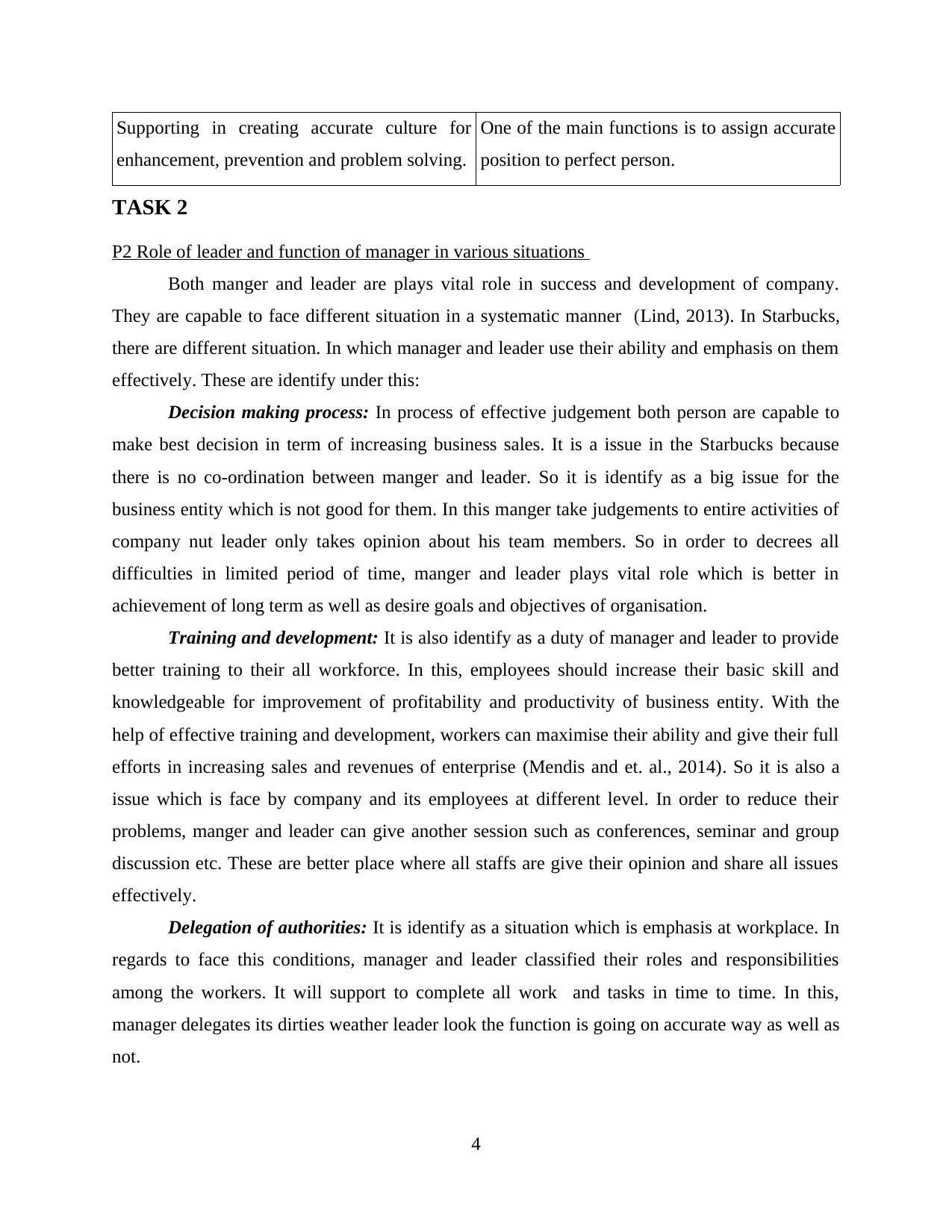
Supporting in creating accurate culture for
enhancement, prevention and problem solving.
One of the main functions is to assign accurate
position to perfect person.
TASK 2
P2 Role of leader and function of manager in various situations
Both manger and leader are plays vital role in success and development of company.
They are capable to face different situation in a systematic manner (Lind, 2013). In Starbucks,
there are different situation. In which manager and leader use their ability and emphasis on them
effectively. These are identify under this:
Decision making process: In process of effective judgement both person are capable to
make best decision in term of increasing business sales. It is a issue in the Starbucks because
there is no co-ordination between manger and leader. So it is identify as a big issue for the
business entity which is not good for them. In this manger take judgements to entire activities of
company nut leader only takes opinion about his team members. So in order to decrees all
difficulties in limited period of time, manger and leader plays vital role which is better in
achievement of long term as well as desire goals and objectives of organisation.
Training and development: It is also identify as a duty of manager and leader to provide
better training to their all workforce. In this, employees should increase their basic skill and
knowledgeable for improvement of profitability and productivity of business entity. With the
help of effective training and development, workers can maximise their ability and give their full
efforts in increasing sales and revenues of enterprise (Mendis and et. al., 2014). So it is also a
issue which is face by company and its employees at different level. In order to reduce their
problems, manger and leader can give another session such as conferences, seminar and group
discussion etc. These are better place where all staffs are give their opinion and share all issues
effectively.
Delegation of authorities: It is identify as a situation which is emphasis at workplace. In
regards to face this conditions, manager and leader classified their roles and responsibilities
among the workers. It will support to complete all work and tasks in time to time. In this,
manager delegates its dirties weather leader look the function is going on accurate way as well as
not.
4
enhancement, prevention and problem solving.
One of the main functions is to assign accurate
position to perfect person.
TASK 2
P2 Role of leader and function of manager in various situations
Both manger and leader are plays vital role in success and development of company.
They are capable to face different situation in a systematic manner (Lind, 2013). In Starbucks,
there are different situation. In which manager and leader use their ability and emphasis on them
effectively. These are identify under this:
Decision making process: In process of effective judgement both person are capable to
make best decision in term of increasing business sales. It is a issue in the Starbucks because
there is no co-ordination between manger and leader. So it is identify as a big issue for the
business entity which is not good for them. In this manger take judgements to entire activities of
company nut leader only takes opinion about his team members. So in order to decrees all
difficulties in limited period of time, manger and leader plays vital role which is better in
achievement of long term as well as desire goals and objectives of organisation.
Training and development: It is also identify as a duty of manager and leader to provide
better training to their all workforce. In this, employees should increase their basic skill and
knowledgeable for improvement of profitability and productivity of business entity. With the
help of effective training and development, workers can maximise their ability and give their full
efforts in increasing sales and revenues of enterprise (Mendis and et. al., 2014). So it is also a
issue which is face by company and its employees at different level. In order to reduce their
problems, manger and leader can give another session such as conferences, seminar and group
discussion etc. These are better place where all staffs are give their opinion and share all issues
effectively.
Delegation of authorities: It is identify as a situation which is emphasis at workplace. In
regards to face this conditions, manager and leader classified their roles and responsibilities
among the workers. It will support to complete all work and tasks in time to time. In this,
manager delegates its dirties weather leader look the function is going on accurate way as well as
not.
4
Paraphrase This Document
Need a fresh take? Get an instant paraphrase of this document with our AI Paraphraser
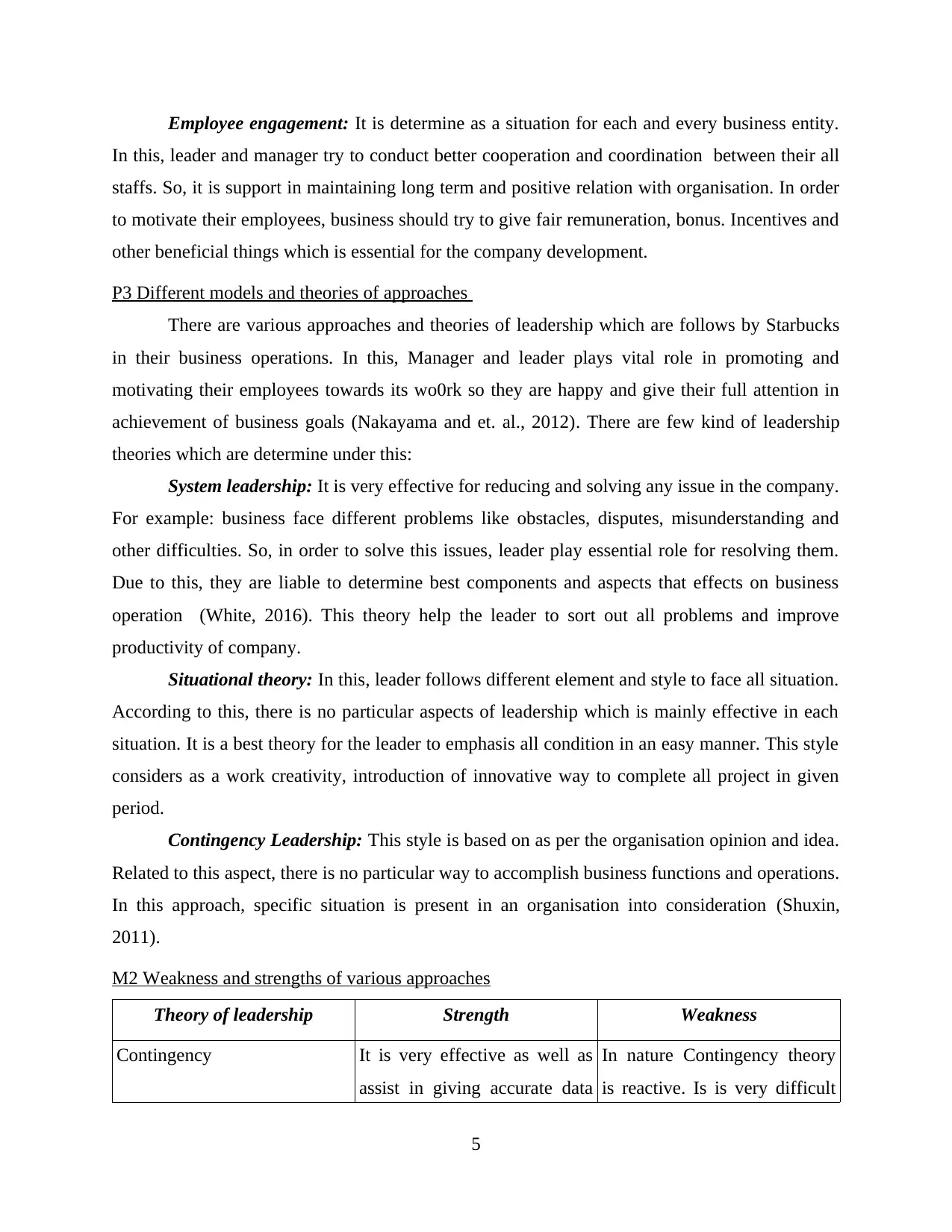
Employee engagement: It is determine as a situation for each and every business entity.
In this, leader and manager try to conduct better cooperation and coordination between their all
staffs. So, it is support in maintaining long term and positive relation with organisation. In order
to motivate their employees, business should try to give fair remuneration, bonus. Incentives and
other beneficial things which is essential for the company development.
P3 Different models and theories of approaches
There are various approaches and theories of leadership which are follows by Starbucks
in their business operations. In this, Manager and leader plays vital role in promoting and
motivating their employees towards its wo0rk so they are happy and give their full attention in
achievement of business goals (Nakayama and et. al., 2012). There are few kind of leadership
theories which are determine under this:
System leadership: It is very effective for reducing and solving any issue in the company.
For example: business face different problems like obstacles, disputes, misunderstanding and
other difficulties. So, in order to solve this issues, leader play essential role for resolving them.
Due to this, they are liable to determine best components and aspects that effects on business
operation (White, 2016). This theory help the leader to sort out all problems and improve
productivity of company.
Situational theory: In this, leader follows different element and style to face all situation.
According to this, there is no particular aspects of leadership which is mainly effective in each
situation. It is a best theory for the leader to emphasis all condition in an easy manner. This style
considers as a work creativity, introduction of innovative way to complete all project in given
period.
Contingency Leadership: This style is based on as per the organisation opinion and idea.
Related to this aspect, there is no particular way to accomplish business functions and operations.
In this approach, specific situation is present in an organisation into consideration (Shuxin,
2011).
M2 Weakness and strengths of various approaches
Theory of leadership Strength Weakness
Contingency It is very effective as well as
assist in giving accurate data
In nature Contingency theory
is reactive. Is is very difficult
5
In this, leader and manager try to conduct better cooperation and coordination between their all
staffs. So, it is support in maintaining long term and positive relation with organisation. In order
to motivate their employees, business should try to give fair remuneration, bonus. Incentives and
other beneficial things which is essential for the company development.
P3 Different models and theories of approaches
There are various approaches and theories of leadership which are follows by Starbucks
in their business operations. In this, Manager and leader plays vital role in promoting and
motivating their employees towards its wo0rk so they are happy and give their full attention in
achievement of business goals (Nakayama and et. al., 2012). There are few kind of leadership
theories which are determine under this:
System leadership: It is very effective for reducing and solving any issue in the company.
For example: business face different problems like obstacles, disputes, misunderstanding and
other difficulties. So, in order to solve this issues, leader play essential role for resolving them.
Due to this, they are liable to determine best components and aspects that effects on business
operation (White, 2016). This theory help the leader to sort out all problems and improve
productivity of company.
Situational theory: In this, leader follows different element and style to face all situation.
According to this, there is no particular aspects of leadership which is mainly effective in each
situation. It is a best theory for the leader to emphasis all condition in an easy manner. This style
considers as a work creativity, introduction of innovative way to complete all project in given
period.
Contingency Leadership: This style is based on as per the organisation opinion and idea.
Related to this aspect, there is no particular way to accomplish business functions and operations.
In this approach, specific situation is present in an organisation into consideration (Shuxin,
2011).
M2 Weakness and strengths of various approaches
Theory of leadership Strength Weakness
Contingency It is very effective as well as
assist in giving accurate data
In nature Contingency theory
is reactive. Is is very difficult
5
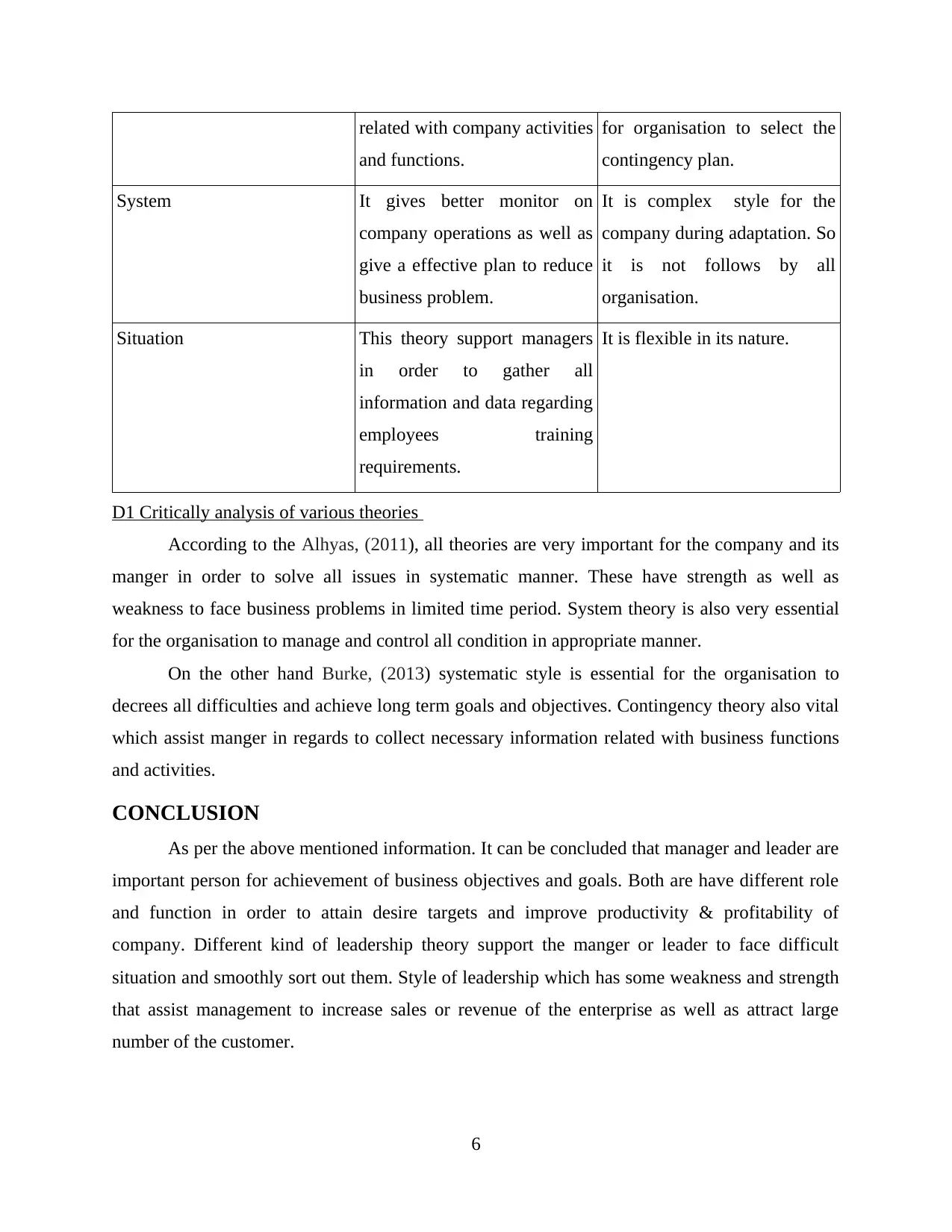
related with company activities
and functions.
for organisation to select the
contingency plan.
System It gives better monitor on
company operations as well as
give a effective plan to reduce
business problem.
It is complex style for the
company during adaptation. So
it is not follows by all
organisation.
Situation This theory support managers
in order to gather all
information and data regarding
employees training
requirements.
It is flexible in its nature.
D1 Critically analysis of various theories
According to the Alhyas, (2011), all theories are very important for the company and its
manger in order to solve all issues in systematic manner. These have strength as well as
weakness to face business problems in limited time period. System theory is also very essential
for the organisation to manage and control all condition in appropriate manner.
On the other hand Burke, (2013) systematic style is essential for the organisation to
decrees all difficulties and achieve long term goals and objectives. Contingency theory also vital
which assist manger in regards to collect necessary information related with business functions
and activities.
CONCLUSION
As per the above mentioned information. It can be concluded that manager and leader are
important person for achievement of business objectives and goals. Both are have different role
and function in order to attain desire targets and improve productivity & profitability of
company. Different kind of leadership theory support the manger or leader to face difficult
situation and smoothly sort out them. Style of leadership which has some weakness and strength
that assist management to increase sales or revenue of the enterprise as well as attract large
number of the customer.
6
and functions.
for organisation to select the
contingency plan.
System It gives better monitor on
company operations as well as
give a effective plan to reduce
business problem.
It is complex style for the
company during adaptation. So
it is not follows by all
organisation.
Situation This theory support managers
in order to gather all
information and data regarding
employees training
requirements.
It is flexible in its nature.
D1 Critically analysis of various theories
According to the Alhyas, (2011), all theories are very important for the company and its
manger in order to solve all issues in systematic manner. These have strength as well as
weakness to face business problems in limited time period. System theory is also very essential
for the organisation to manage and control all condition in appropriate manner.
On the other hand Burke, (2013) systematic style is essential for the organisation to
decrees all difficulties and achieve long term goals and objectives. Contingency theory also vital
which assist manger in regards to collect necessary information related with business functions
and activities.
CONCLUSION
As per the above mentioned information. It can be concluded that manager and leader are
important person for achievement of business objectives and goals. Both are have different role
and function in order to attain desire targets and improve productivity & profitability of
company. Different kind of leadership theory support the manger or leader to face difficult
situation and smoothly sort out them. Style of leadership which has some weakness and strength
that assist management to increase sales or revenue of the enterprise as well as attract large
number of the customer.
6
⊘ This is a preview!⊘
Do you want full access?
Subscribe today to unlock all pages.

Trusted by 1+ million students worldwide
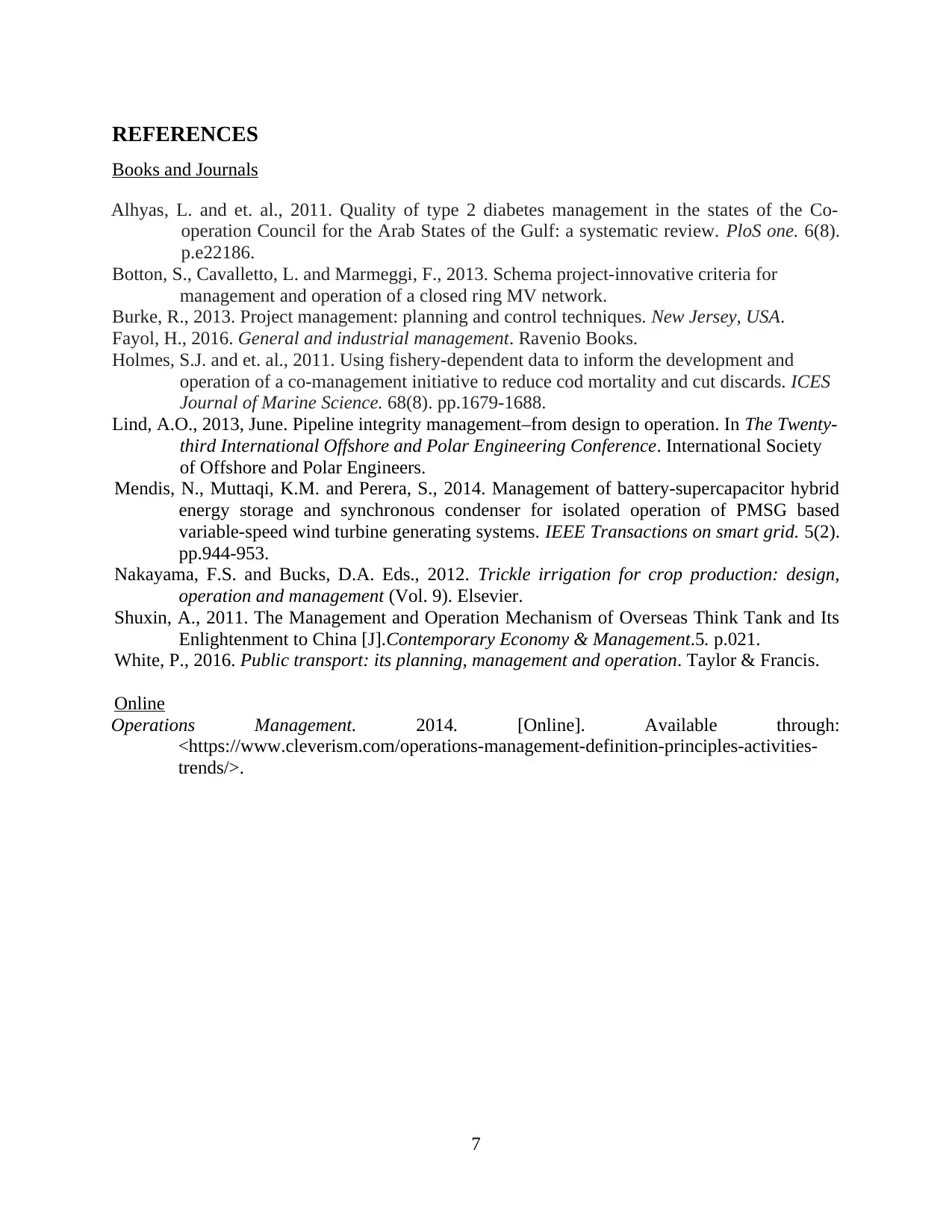
REFERENCES
Books and Journals
Alhyas, L. and et. al., 2011. Quality of type 2 diabetes management in the states of the Co-
operation Council for the Arab States of the Gulf: a systematic review. PloS one. 6(8).
p.e22186.
Botton, S., Cavalletto, L. and Marmeggi, F., 2013. Schema project-innovative criteria for
management and operation of a closed ring MV network.
Burke, R., 2013. Project management: planning and control techniques. New Jersey, USA.
Fayol, H., 2016. General and industrial management. Ravenio Books.
Holmes, S.J. and et. al., 2011. Using fishery-dependent data to inform the development and
operation of a co-management initiative to reduce cod mortality and cut discards. ICES
Journal of Marine Science. 68(8). pp.1679-1688.
Lind, A.O., 2013, June. Pipeline integrity management–from design to operation. In The Twenty-
third International Offshore and Polar Engineering Conference. International Society
of Offshore and Polar Engineers.
Mendis, N., Muttaqi, K.M. and Perera, S., 2014. Management of battery-supercapacitor hybrid
energy storage and synchronous condenser for isolated operation of PMSG based
variable-speed wind turbine generating systems. IEEE Transactions on smart grid. 5(2).
pp.944-953.
Nakayama, F.S. and Bucks, D.A. Eds., 2012. Trickle irrigation for crop production: design,
operation and management (Vol. 9). Elsevier.
Shuxin, A., 2011. The Management and Operation Mechanism of Overseas Think Tank and Its
Enlightenment to China [J].Contemporary Economy & Management.5. p.021.
White, P., 2016. Public transport: its planning, management and operation. Taylor & Francis.
Online
Operations Management. 2014. [Online]. Available through:
<https://www.cleverism.com/operations-management-definition-principles-activities-
trends/>.
7
Books and Journals
Alhyas, L. and et. al., 2011. Quality of type 2 diabetes management in the states of the Co-
operation Council for the Arab States of the Gulf: a systematic review. PloS one. 6(8).
p.e22186.
Botton, S., Cavalletto, L. and Marmeggi, F., 2013. Schema project-innovative criteria for
management and operation of a closed ring MV network.
Burke, R., 2013. Project management: planning and control techniques. New Jersey, USA.
Fayol, H., 2016. General and industrial management. Ravenio Books.
Holmes, S.J. and et. al., 2011. Using fishery-dependent data to inform the development and
operation of a co-management initiative to reduce cod mortality and cut discards. ICES
Journal of Marine Science. 68(8). pp.1679-1688.
Lind, A.O., 2013, June. Pipeline integrity management–from design to operation. In The Twenty-
third International Offshore and Polar Engineering Conference. International Society
of Offshore and Polar Engineers.
Mendis, N., Muttaqi, K.M. and Perera, S., 2014. Management of battery-supercapacitor hybrid
energy storage and synchronous condenser for isolated operation of PMSG based
variable-speed wind turbine generating systems. IEEE Transactions on smart grid. 5(2).
pp.944-953.
Nakayama, F.S. and Bucks, D.A. Eds., 2012. Trickle irrigation for crop production: design,
operation and management (Vol. 9). Elsevier.
Shuxin, A., 2011. The Management and Operation Mechanism of Overseas Think Tank and Its
Enlightenment to China [J].Contemporary Economy & Management.5. p.021.
White, P., 2016. Public transport: its planning, management and operation. Taylor & Francis.
Online
Operations Management. 2014. [Online]. Available through:
<https://www.cleverism.com/operations-management-definition-principles-activities-
trends/>.
7
1 out of 10
Related Documents
Your All-in-One AI-Powered Toolkit for Academic Success.
+13062052269
info@desklib.com
Available 24*7 on WhatsApp / Email
![[object Object]](/_next/static/media/star-bottom.7253800d.svg)
Unlock your academic potential
Copyright © 2020–2025 A2Z Services. All Rights Reserved. Developed and managed by ZUCOL.





